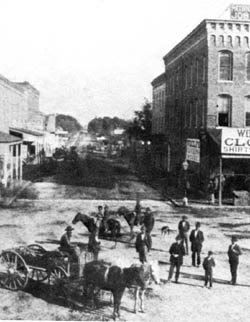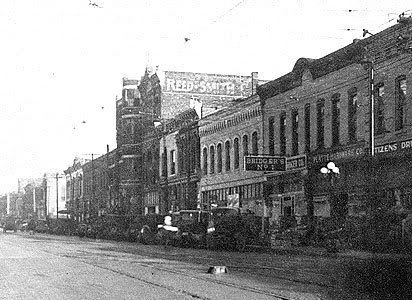I have always been interested in the history of things. It seems that every time I learn some history on something that thing becomes much more understood and a lot more interesting. I'm probably a little biased since I've also always liked antiques and old things. I like things that have a story to them. It's why I drive a 1959 Ford, recently bought a 1909 house, and have several pieces of furniture that date back to the turn of the century (no, not 2000).
Being born in Springfield and never living more than 10 miles away from it in my 27 years has provided me many, many snippets of history on the city. A lot of these interesting facts are true and some have turned out not to be, but I would like to share a little bit of true history about the city in which I have always proudly lived. I promise that it won't be boring. Or at least to me, anyway.
John Polk Campbell was the man that decided this was a pretty good spot to put his farm. At this time he was among several pioneers from Tennessee who had gone out looking for new land to settle in. He liked this spot near a spring and carved his name on an Ash tree to claim the land. He came back in 1830 with his family to settle here only to find that the Fulbright brothers had already settled here (William, John, and Levi and their wives and children). He still had his land that he claimed which was adjacent to the Fulbrights' farm. The area then became known to other settlers as "Campbell and Fulbright Springs".
In 1835, Campbell donated 50 acres of land to the township of people which was named Springfield with the help of Campbell among others. Thanks for the donation, John. It must have been difficult scratching your name off that tree or did you just cut it down? Don't you wish that you could just go out in the woods and claim land? Anyway, Springfield grew quite steadily throughout the next 30 years and boasted a population of 3,300 by the Civil War.
It was around 1870 that an act took place in Springfield that changed it forever. The effects of this act still linger today and most Springfield residents feel them and see them, but they know nothing of their origin. In 1870, Springfield would benefit from the introduction of a railroad near its borders. However, this is where the problem was. Springfield had heard that the Southern Pacific Rail Road was going to come through Springfield and this meant all kinds of new opportunities for Springfield residents. It meant new jobs, new money, cheaper goods, and growth. Residents eagerly anticipated the railroad's arrival to be shocked when they heard that the company decided to go around Springfield instead of through it. The railroad was built north of town and also put a depot south of town as well.
The southern depot wound up becoming a town much later known as Galloway Station, which was swallowed up by Springfield in the early 1970's. However, the tracks to the north of town can be found still in use today just north of Commercial Street. Here is what happened. Springfield had been a town for decades and was well-established and, while they were grateful they would be receiving a railroad to their town, they were hurt by the railroad's decision to build north of town. See, along with the railroad came investors and business people from out of state who came and set up shop. They were from bigger towns and cities and they came to make even more money. They started building rather quickly and before long there was a noticeable two sections of town. Springfield became known as "old town" and the Commercial Street area became "new town". In July of 1870, the Greene County Court made an order incorporating the town "North Springfield". At the same time, five of the new investors were named as Trustees of the said town. These orders were made "on petition of two-thirds of the citizens" of the would-be town, but were later discovered to be illegal in that these people hadn't lived here long enough to have even gained Missouri citizenship. therefore the original orders were rescinded. In 1871, the town was again incorporated, though this time legally.
Here is what happened. Springfield had been a town for decades and was well-established and, while they were grateful they would be receiving a railroad to their town, they were hurt by the railroad's decision to build north of town. See, along with the railroad came investors and business people from out of state who came and set up shop. They were from bigger towns and cities and they came to make even more money. They started building rather quickly and before long there was a noticeable two sections of town. Springfield became known as "old town" and the Commercial Street area became "new town". In July of 1870, the Greene County Court made an order incorporating the town "North Springfield". At the same time, five of the new investors were named as Trustees of the said town. These orders were made "on petition of two-thirds of the citizens" of the would-be town, but were later discovered to be illegal in that these people hadn't lived here long enough to have even gained Missouri citizenship. therefore the original orders were rescinded. In 1871, the town was again incorporated, though this time legally. As you can imagine, there were mixed feelings over this new "town" encroaching on Springfield's rightfully earned prosperity. They even named the street that became the shared border between them Division Street. In 1874, Springfield introduced a bill to Congress that requested that Springfield's borders be extended to incorporate North Springfield. The bill passed, but with a contingency that both towns vote on the matter. North Springfield residents turned out a poll showing that they voted 78 to 1 opposing the annexation. The single "yes" vote was from Frank Lawson who was said to have voted the approval as a joke. Funny guy.
As you can imagine, there were mixed feelings over this new "town" encroaching on Springfield's rightfully earned prosperity. They even named the street that became the shared border between them Division Street. In 1874, Springfield introduced a bill to Congress that requested that Springfield's borders be extended to incorporate North Springfield. The bill passed, but with a contingency that both towns vote on the matter. North Springfield residents turned out a poll showing that they voted 78 to 1 opposing the annexation. The single "yes" vote was from Frank Lawson who was said to have voted the approval as a joke. Funny guy.
With rivalry growing in strength, the two finally consolidated its borders to become Springfield in 1887. I'm sure that their backing down off their high horses had nothing to do with the closing down of the Benton Street station to move to the station closer to Springfield's downtown in 1878. Surely not. This rivalry, while only 17 years in the making, still haunts Springfield 120 years later. I have heard countless statements from both sides towards the other that reveal a venomous contempt that lingers just beneath the surface. Most of the reasons that people have for their contempt have little to do with the original reason, but the competition remains. I don't recall there ever being a west side-east side thing. And I don't recall anyone from either side ever having anything bad to say about their opposite.
What do you think?
skip to main |
skip to sidebar

- Home
- Downloads
- Software
- Excel Creations
- GIMP Creations
- World Cup 2022 Printable Poster (PNG)
- World Cup 2018 Printable Poster (PDF)
- World Cup 2018 Printable Poster (PNG)
- Copa America 2016 Printable Poster (PDF)
- Copa America 2016 Printable Poster (PNG)
- Euro 2016 Printable Poster (PDF)
- Euro 2016 Printable Poster (PNG)
- World Cup 2014 Printable Poster (PDF)
- World Cup 2014 Printable Poster (JPG)
- Deck
- Sketchup Creations
- Blogs I Read
Labels
autobiography
(94)
home renovation
(64)
family
(62)
DIY
(56)
God
(45)
observation
(37)
food
(34)
opinion
(34)
truth
(34)
debate
(32)
life
(32)
automobiles
(30)
inspiration
(30)
comedy
(28)
history
(27)
controversy
(26)
politics
(24)
belief
(23)
Before & After
(22)
friends
(22)
health
(21)
Craigslist
(19)
technology
(19)
love
(18)
photography
(18)
marriage
(17)
soccer
(16)
work
(16)
art
(15)
Ford
(13)
game
(11)
movie
(11)
green
(10)
music
(10)
software
(8)
GIMP
(7)
creation
(6)
garden
(6)
9/11
(5)
Excel
(5)
book review
(5)
birthday
(3)
travel
(1)
Video
Profile

- Levi Felton
- I'm difficult to explain, but I will attempt. I am a fantastic husband, father, and employee. I have an amazing array of talents. I never stop leaving others in awe with my actions. I love my life, because my life is so great that it's virtually impossible not to love it. Finally, I also have a fair amount of self esteem. And people say that I'm often sarcastic but I don't know why.
Categories
autobiography
(94)
home renovation
(64)
family
(62)
DIY
(56)
God
(45)
observation
(37)
food
(34)
opinion
(34)
truth
(34)
debate
(32)
life
(32)
automobiles
(30)
inspiration
(30)
comedy
(28)
history
(27)
controversy
(26)
politics
(24)
belief
(23)
Before & After
(22)
friends
(22)
health
(21)
Craigslist
(19)
technology
(19)
love
(18)
photography
(18)
marriage
(17)
soccer
(16)
work
(16)
art
(15)
Ford
(13)
game
(11)
movie
(11)
green
(10)
music
(10)
software
(8)
GIMP
(7)
creation
(6)
garden
(6)
9/11
(5)
Excel
(5)
book review
(5)
birthday
(3)
travel
(1)
Design by Free WordPress Themes | Bloggerized by Lasantha - Premium Blogger Themes | Blogger Templates




2 comments:
Thats actually really cool history. I rather enjoyed reading that and for me that is a big deal!
You so smart. :) You should be a Springfield historian speaker guy. Just don't have me as your sidekick cuz that was some bad english.
Post a Comment